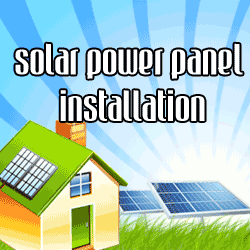

Utilizing the solar system, instead of fuel, for space heating is part of GREEN. And that's where solar homes come in.
The Traditional Way: Active Solar Homes
Early on, architects learned to harness the sun to heat our homes and minimize our dependence on imported oil. South-facing solar panels on the roof, with circulating water, can produce free domestic hot water. This system is still popular and is cost-effective.
Multiple such panels, with anti-freeze liquid instead of water, and with elaborate pumps and insulated storage tanks have been used for space heating. This system is called "active solar," due to the hardware involved in the system, and it is not cost-effective.
Another upcoming system, born out of the space age, is "photovoltaic." Photovoltaic roof panels use sun power to run the house's entire electrical system. This option is clean, efficient and almost care-free, but very costly to install. However, it does have future potentials as costs come down.
The Practical Way: Passive Solar Homes
"Passive solar" is an old concept with a new shine. Energy-saving passive solar does away with costly panels and mechanical devices and taps directly into the sun's energy and house orientation to heat the home. The advancement of technology and available materials has further enhanced the system.
So what's in a passive solar home? A typical one has the major rooms facing south, or nearly-south. The house is constructed with thick insulation in walls and ceilings to keep the house warm in winter and cool in summer. Window and door glazing is double-paned for better insulation (in colder climates, triple-glazing is recommended). A wood-burning stove is selected over a fireplace to optimize heat efficiency.
Most windows and glass doors are on the south side for solar gain. Roof overhangs shade the house from high summer sun. Strategically placed clerestory windows create air circulation by convection for summer cooling.
Benefits and Limitations
Passive solar homes work when solar radiation is collected inside the home and stored in sun spaces, such as sun rooms, and also in thermal media areas, such as masonry walls and thick, ceramic-finished concrete floors. Solar heat stored in these elements is then slowly released after sunset to keep the home warm.
Passive solar has its limitations, too. For instance, some lots might not be fit for solar homes, such as when the site is overwhelmed by tall trees or a barrier. Also, solar design usually requires some sort of back-up heating system for prolonged sunless days or severe weather.
The Bottom Line
It is estimated that passive solar homes can cut fuel consumption by almost 60% or more, especially when wood-burning stoves are utilized. So consider going green and building a passive solar home for your family.
Sustainable Living Articles @ http://www.articlegarden.com
About Charles Koty, A.I.A.:
Charles Koty is an award-winning architect, specializing in passive solar homes, with plans featured in numerous home magazines including Better Homes and Gardens, Architectural Designs, House Beautiful, and many others. View his available home plans at www.nationalhomeplans.com




0 comments:
Post a Comment